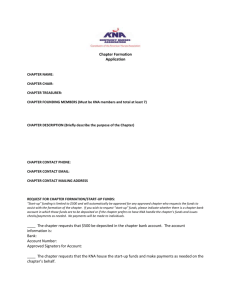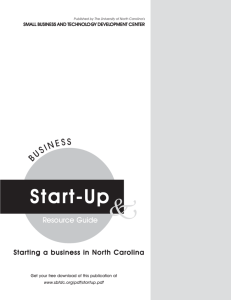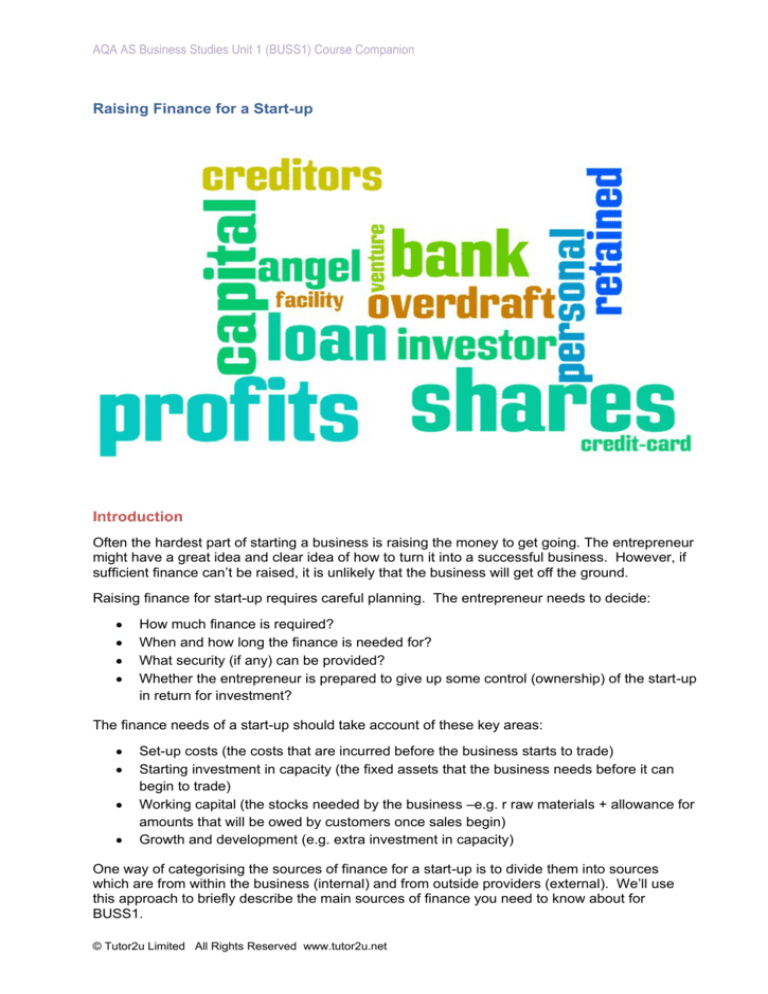
AQA AS Business Studies Unit 1 (BUSS1) Course Companion
Raising Finance for a Start-up
Introduction
Often the hardest part of starting a business is raising the money to get going. The entrepreneur
might have a great idea and clear idea of how to turn it into a successful business. However, if
sufficient finance can’t be raised, it is unlikely that the business will get off the ground.
Raising finance for start-up requires careful planning. The entrepreneur needs to decide:
How much finance is required?
When and how long the finance is needed for?
What security (if any) can be provided?
Whether the entrepreneur is prepared to give up some control (ownership) of the start-up
in return for investment?
The finance needs of a start-up should take account of these key areas:
Set-up costs (the costs that are incurred before the business starts to trade)
Starting investment in capacity (the fixed assets that the business needs before it can
begin to trade)
Working capital (the stocks needed by the business –e.g. r raw materials + allowance for
amounts that will be owed by customers once sales begin)
Growth and development (e.g. extra investment in capacity)
One way of categorising the sources of finance for a start-up is to divide them into sources
which are from within the business (internal) and from outside providers (external). We’ll use
this approach to briefly describe the main sources of finance you need to know about for
BUSS1.
© Tutor2u Limited All Rights Reserved www.tutor2u.net
AQA AS Business Studies Unit 1 (BUSS1) Course Companion
Internal sources
The main internal sources of finance for a start-up are as follows:
Personal sources
These are the most important sources of finance for a start-up, and we deal with them in more
detail in a later section.
Retained profits
This is the cash that is generated by the business when it trades profitably – another important
source of finance for any business, large or small.
Note that retained profits can generate cash the moment trading has begun. For example,
a start-up sells the first batch of stock for £5,000 cash which it had bought for £2,000. That
means that retained profits are £3,000 which can be used to finance further expansion or to pay
for other trading costs and expenses.
It is a mistake to believe (as one BUSS1 textbook does) that start-ups are not financed by
retained profits. You don’t have to wait for the business as a whole to make profits before you
can start reinvesting profits earned on individual products.
Share capital – invested by the founder
The founding entrepreneur (/s) may decide to invest in the share capital of a company, founded
for the purpose of forming the start-up. This is a common method of financing a start-up. The
founder provides all the share capital of the company, retaining 100% control over the business.
The advantages of investing in share capital are covered in the section on business structure.
The key point to note here is that the entrepreneur may be using a variety of personal sources to
invest in the shares. Once the investment has been made, it is the company that owns the
money provided. The shareholder obtains a return on this investment through dividends
(payments out of profits) and/or the value of the business when it is eventually sold.
A start-up company can also raise finance by selling shares to external investors – this is
covered further below.
External sources
Loan capital
This can take several forms, but the most common are a bank loan or bank overdraft.
A bank loan provides a longer-term kind of finance for a start-up, with the bank stating the
fixed period over which the loan is provided (e.g. 5 years), the rate of interest and the timing and
amount of repayments. The bank will usually require that the start-up provide some security for
the loan, although this security normally comes in the form of personal guarantees provided by
the entrepreneur. Bank loans are good for financing investment in fixed assets and are
generally at a lower rate of interest that a bank overdraft. However, they don’t provide much
flexibility.
A bank overdraft is a more short-term kind of finance which is also widely used by start-ups
and small businesses. An overdraft is really a loan facility – the bank lets the business “owe it
money” when the bank balance goes below zero, in return for charging a high rate of interest. As
a result, an overdraft is a flexible source of finance, in the sense that it is only used when
© Tutor2u Limited All Rights Reserved www.tutor2u.net
AQA AS Business Studies Unit 1 (BUSS1) Course Companion
needed. Bank overdrafts are excellent for helping a business handle seasonal fluctuations in
cash flow or when the business runs into short-term cash flow problems (e.g. a major customer
fails to pay on time).
Two further loan-related sources of finance are worth knowing about:
The Small Firms Loan Guarantee Scheme is a government-funded scheme that makes it
easier for businesses to obtain a bank loan. In return for paying a slightly higher interest rate,
loans of up to £250,000 made by banks under the SGLGS are backed by the Government. The
scheme is a useful way of start-ups and small businesses getting bank loans when they are not
able to offer the banks suitable security.
The Princes Trust is a well-known provider of start-up business finance for young and
disadvantaged people. It provides low-interest loans of up to £4,000 together with the support of
a business mentor.
Share capital – outside investors
For a start-up, the main source of outside (external) investor in the share capital of a company is
friends and family of the entrepreneur. Opinions differ on whether friends and family should be
encouraged to invest in a start-up company. They may be prepared to invest substantial
amounts for a longer period of time; they may not want to get too involved in the day-to-day
operation of the business. Both of these are positives for the entrepreneur. However, there are
pitfalls. Almost inevitably, tensions develop with family and friends as fellow shareholders.
Business angels are the other main kind of external investor in a start-up company. Business
angels are professional investors who typically invest £10k - £750k. They prefer to invest in
businesses with high growth prospects. Angels tend to have made their money by setting up
and selling their own business – in other words they have proven entrepreneurial expertise. In
addition to their money, Angels often make their own skills, experience and contacts available to
the company. Getting the backing of an Angel can be a significant advantage to a start-up,
although the entrepreneur needs to accept a loss of control over the business.
You will also see Venture Capital mentioned as a source of finance for start-ups. You need to
be careful here. Venture capital is a specific kind of share investment that is made by funds
managed by professional investors. Venture capitalists rarely invest in genuine start-ups or
small businesses (their minimum investment is usually over £1m, often much more). They
prefer to invest in businesses which have established themselves. Another term you may here
is “private equity” – this is just another term for venture capital.
A start-up is much more likely to receive investment from a business angel than a venture
capitalist.
Personal sources
As mentioned earlier, most start-ups make use of the personal financial arrangements of the
founder. This can be personal savings or other cash balances that have been accumulated. It
can be personal debt facilities which are made available to the business. It can also simply be
the found working for nothing! The following notes explain these in a little more detail.
Savings and other “nest-eggs”
An entrepreneur will often invest personal cash balances into a start-up. This is a cheap form of
finance and it is readily available. Often the decision to start a business is prompted by a change
in the personal circumstances of the entrepreneur – e.g. redundancy or an inheritance.
Investing personal savings maximises the control the entrepreneur keeps over the business. It
is also a strong signal of commitment to outside investors or providers of finance.
© Tutor2u Limited All Rights Reserved www.tutor2u.net
AQA AS Business Studies Unit 1 (BUSS1) Course Companion
Re-mortgaging is the most popular way of raising loan-related capital for a start-up. The way
this works is simple. The entrepreneur takes out a second or larger mortgage on a private
property and then invests some or all of this money into the business. The use of mortgaging
like this provides access to relatively low-cost finance, although the risk is that, if the business
fails, then the property will be lost too. The credit crunch in 2008 has reduced the availability
and increased the cost of this kind of finance.
Borrowing from friends and family
This is also common. Friends and family who are supportive of the business idea provide
money either directly to the entrepreneur or into the business. This can be quicker and cheaper
to arrange (certainly compared with a standard bank loan) and the interest and repayment terms
may be more flexible than a bank loan. However, borrowing in this way can add to the stress
faced by an entrepreneur, particularly if the business gets into difficulties.
Credit cards
This is a surprisingly popular way of financing a start-up. In fact, the use of credit cards is the
most common source of finance amongst small businesses. It works like this. Each month, the
entrepreneur pays for various business-related expenses on a credit card. 15 days later the
credit card statement is sent in the post and the balance is paid by the business within the
credit-free period. The effect is that the business gets access to a free credit period of
aroudn30-45 days!
Choosing the right source of finance
The following factors need to be considered when deciding on the best mix of finance for a startup:
Control
Entrepreneurs are always best advised to hang onto as much control of
their business as possible. Selling shares in the business to external
investors (including friends and family) loosens that control. At the very
least, an entrepreneur needs to have control over 51% of the shares in
order to have the final say on key business decisions in a company
Cost
The basic rule of thumb is that finance provided by the founder (or
reinvested from retained profits) is the cheapest.
Somewhat more expensive is loan finance – typically priced at around 510 above the base interest rate, depending on the nature of the loan. If
the entrepreneur can provide security for the loan, then the interest is
usually cheaper than “unsecured” debt. This reflects that the security
reduces the risk taken by the lender.
The most expensive finance is generally from external investors. They
will typically require a much higher return than a bank. Business angels
look to achieve annual returns of around 30-50% from an investment –
although they are prepared to wait for the business to be sold before all
this return is realised.
Amount
The amount of finance required by a start-up varies depending on factors
such as the length of the period before break-even is achieved and the
investment required in fixed assets & product development.
Smaller amounts (e.g. £1k-20k) are generally funded by a combination of
© Tutor2u Limited All Rights Reserved www.tutor2u.net
AQA AS Business Studies Unit 1 (BUSS1) Course Companion
personal sources, friends & family loans and perhaps a little help from a
bank. Business angels might be interested once the amount goes above
£10k.
Much larger amounts than this are quite complicated to arrange. Banks
and external investors will want to see the founding entrepreneur invest
his/her money too, both as a sign of commitment to the idea and also to
tie them into the business (give them something to lose!)
Timing
Remember that a start-up doesn’t have to raise all is finance at once.
One sensible approach is to go through a series of finance-raisings,
obtaining money when the business actually needs it.
Flexibility
Some sources of finance are more flexible than others. The most flexible
is the bank overdraft, which is a facility that a business uses as
necessary. If the business goes overdrawn by £15,000, then it pays
interest on that amount. If the cash comes in and the bank overdraft falls
to £5,000, then interest is paid on the lower amount.
Contrast this with a bank loan. Interest is paid on the whole amount
loaned – whether or not the business has made use of the funds.
Exam tips
It is vital that a start-up chooses sources of finance that are appropriate and sufficient for its
needs. Remember that too much finance of the wrong sort (e.g. an unnecessary large bank
loan) can create huge problems for a start-up.
You must appreciate that many start-ups find it hard to raise finance until they have established
a trading record. It is almost always up to the founder to invest funds to get things going.
Entrepreneurs are best-advised to retain as much control over their business as possible. That
means not selling substantial proportions of the share capital to other investors.
A well run start-up uses its cash flow forecasts to identify when additional finance is required.
This means that a start-up may choose to raise finance at several stages - not always right at
the start of trading.
As always, make sure you can list the advantages and disadvantages of the various forms of
finance.
© Tutor2u Limited All Rights Reserved www.tutor2u.net
AQA AS Business Studies Unit 1 (BUSS1) Course Companion
Guided revision questions
Revision questions for Sources of Finance for a Start-up
(1) List three reasons why a start-up needs to raise finance (3 marks)
(2) Define the term “retained profits” (2 marks)
(3) List three personal sources of finance (3 marks)
(4) Explain why the founder of a start-up might want to own the entire ordinary share capital
of the company (5 marks)
(5) Define the terms “bank loan” and “bank overdraft” (4 marks)
(6) Explain why a bank loan would be an appropriate source of finance for the purchase of
plant and equipment for a new factory (4 marks)
(7) State two disadvantages of using a bank loan to finance a start-up (3 marks)
(8) Give two examples for each of internal and external sources of finance (4 marks)
(9) Explain why working capital is so important to a start-up (4 marks)
(10)
Define the term “trade credit” (2 marks)
(11)
Why might an entrepreneur use a personal credit card as a source of finance for
a start-up? (3 marks)
(12)
Using two examples of each, explain the difference between capital expenditure
and revenue expenditure (6 marks)
(13)
What is a business angel and why do they invest in small businesses? (4 marks)
(14)
Explain why venture capitalists rarely invest in start-ups (4 marks)
(15)
Outline the possible advantages and disadvantages of an entrepreneur financing
a start-up with loans from friends and family (4 marks)
(16)
Outline four factors that need to be considered in choosing the best sources of
finance for a start-up (4 marks)
© Tutor2u Limited All Rights Reserved www.tutor2u.net

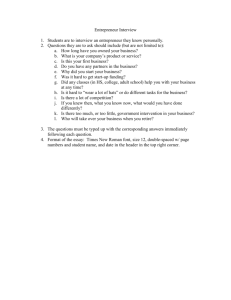
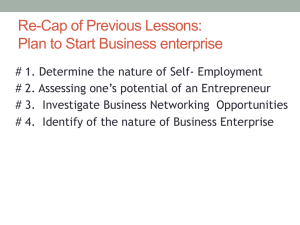

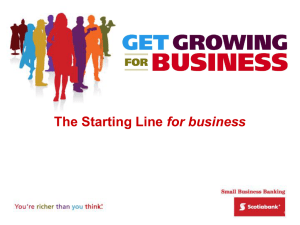
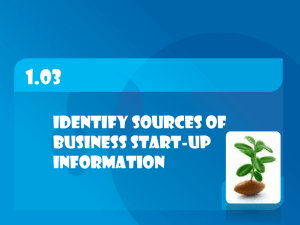

![[Name of Business]](http://s2.studylib.net/store/data/005439490_1-eb485795b6ab94ac46e88cc0426770e1-300x300.png)
